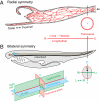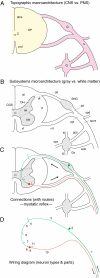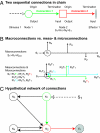Foundational model of structural connectivity in the nervous system with a schema for wiring diagrams, connectome, and basic plan architecture
- PMID: 21078980
- PMCID: PMC2996420
- DOI: 10.1073/pnas.1015128107
Foundational model of structural connectivity in the nervous system with a schema for wiring diagrams, connectome, and basic plan architecture
Abstract
The nervous system is a biological computer integrating the body's reflex and voluntary environmental interactions (behavior) with a relatively constant internal state (homeostasis)-- promoting survival of the individual and species. The wiring diagram of the nervous system's structural connectivity provides an obligatory foundational model for understanding functional localization at molecular, cellular, systems, and behavioral organization levels. This paper provides a high-level, downwardly extendible, conceptual framework--like a compass and map--for describing and exploring in neuroinformatics systems (such as our Brain Architecture Knowledge Management System) the structural architecture of the nervous system's basic wiring diagram. For this, the Foundational Model of Connectivity's universe of discourse is the structural architecture of nervous system connectivity in all animals at all resolutions, and the model includes two key elements--a set of basic principles and an internally consistent set of concepts (defined vocabulary of standard terms)--arranged in an explicitly defined schema (set of relationships between concepts) allowing automatic inferences. In addition, rules and procedures for creating and modifying the foundational model are considered. Controlled vocabularies with broad community support typically are managed by standing committees of experts that create and refine boundary conditions, and a set of rules that are available on the Web.
Conflict of interest statement
The authors declare no conflict of interest.
Figures







References
-
- Tiedemann F. Anatomy of the Foetal Brain. Edinburgh: Carfrae; 1826. p. 2.
-
- Meadows DM. Thinking in Systems. White River Junction, VT: Chelsea Green; 2008. p. 1.
-
- Watson JD, Crick FHC. Molecular structure of nucleic acids: A structure for deoxyribose nucleic acid. Nature. 1953;171:737–738. - PubMed
-
- Bota M, Dong H-W, Swanson LW. From gene networks to brain networks. Nat Neurosci. 2003;6:795–799. - PubMed
Publication types
MeSH terms
Grants and funding
LinkOut - more resources
Full Text Sources

